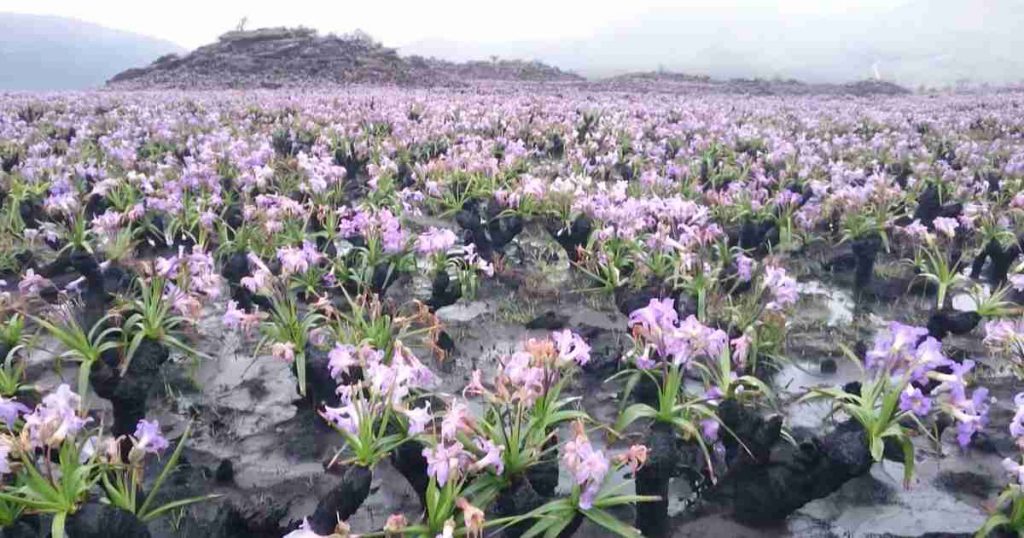Candombá or Vellozia sincorana is a typical and endemic flower of the Rupestrian Fields of the Chapada Diamantina National Park.
Candombá, which hadn’t flowered for 17 years, has reappeared in a recently burnt area, transforming the landscape.

This species has several characteristics that make it unique and endemic:
- Endemicity: The Candombá is found exclusively in the Rupestrian Fields of the Chapada Diamantina, which means that it is found nowhere else in the world.
- Dependence on fire: This species has a unique relationship with fire, as it depends on it to thrive. Fire stimulates growth and flowering, and the plants flower about 30 days after a fire.
- Morphological adaptations: Candombá has morphological characteristics adapted to the rupestrian field environment, such as resistant leaves and a deep root system that helps to absorb water in poor, drained soils.
- Rare flowering: The flowering of the Candombá is a rare event, occurring only once every 17 years, which makes it all the more special and remarkable.
- Fabulous nectar: The amount of nectar produced by its flowers is considerable, which attracts pollinators and contributes to the ecological diversity of the habitat.
- Ecological importance: In addition to its aesthetic value, the Candombá plays an important role in the local ecosystem, helping to maintain biodiversity and providing resources for several species of pollinators.
The Candombá has bloomed again on burnt tree stumps in an area devastated by a fire in the Serra da Larguinha, between the municipalities of Palmeiras and Lençóis.
Images of the valley of flowers of the Candombá species that had formed on the site were captured by a photographer who was trekking through the Vale do Capão to reach the Cachoeira da Fumaça, the second highest waterfall in Brazil, when he came across this rare scene.
“It was a pleasant surprise. We were heading for Cachoeira da Fumaça from below. During the hike, I came across this scene on the way up. In nature photography we always come across impressive scenes. And this time was no different,” he said.

Candombá na Chapada Diamantina
According to botanist Abel Augusto Conceição of the State University of Feira de Santana (Uefs), the flowers of the Candombá species depend on fire to bloom.
In the last three months of last year, fires devastated 51,000 hectares in Bahia, according to the Bahia Environmental Secretariat.
Of the total, 15,000 hectares affected by the flames are in the National Park, an environmental protection area that covers six municipalities. The fires were only fully extinguished after the January rains.
“This lush and magnificent flowering is an extremely rare sight. This population of Candombá flowered 17 years ago and has only just begun to flower again. It is fire dependent and only flowers when there is fire. So if there is no fire, there will be no flowers. This species is found only in the Chapada National Park.
In the case of Candombá, it blooms 30 days after the fire. What’s more, the amount of nectar is fabulous,” says the expert.
Throughout his career, the photographer says he has photographed the Chapada Diamantina several times, including during the fires caused by human activity last year.
“The trees burn completely. The black stump remains, and anyone who looks will be absolutely certain that the plant is dead. It’s a fantastic scene. It’s a natural thing. Man comes with fire and nature responds with flowers,” he says.
Chapada Diamantina Tourist Guide.
Publicações Relacionadas
Spinner Dolphins in Fernando de Noronha: A Guide
Orchids of the Chapada Diamantina in Bahia
Orchid grower collects more than 300 species in Recife
Boqueirão da Onça: A Unique Brazilian Eco-Treasure
Environmental Wealth of Maranhão: A Tropical Paradise
Marechal Newton Cavalcanti Educational Centre Overview
Orchids: Tips and Techniques for Efficient Cultivation and Care
Tropical flowers are grown on a large scale in northeastern Brazil
Sea turtle species found in Brazil
This post is also on:
![]() Português
Português ![]() English
English ![]() Deutsch
Deutsch ![]() Español
Español ![]() Français
Français



















